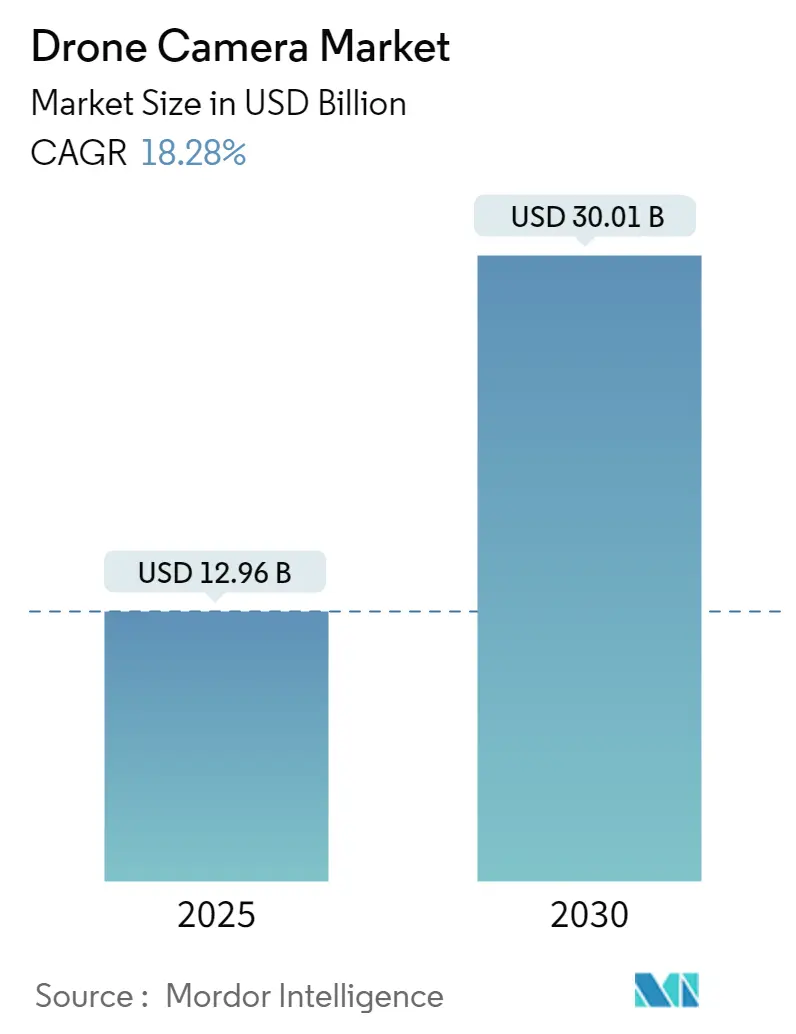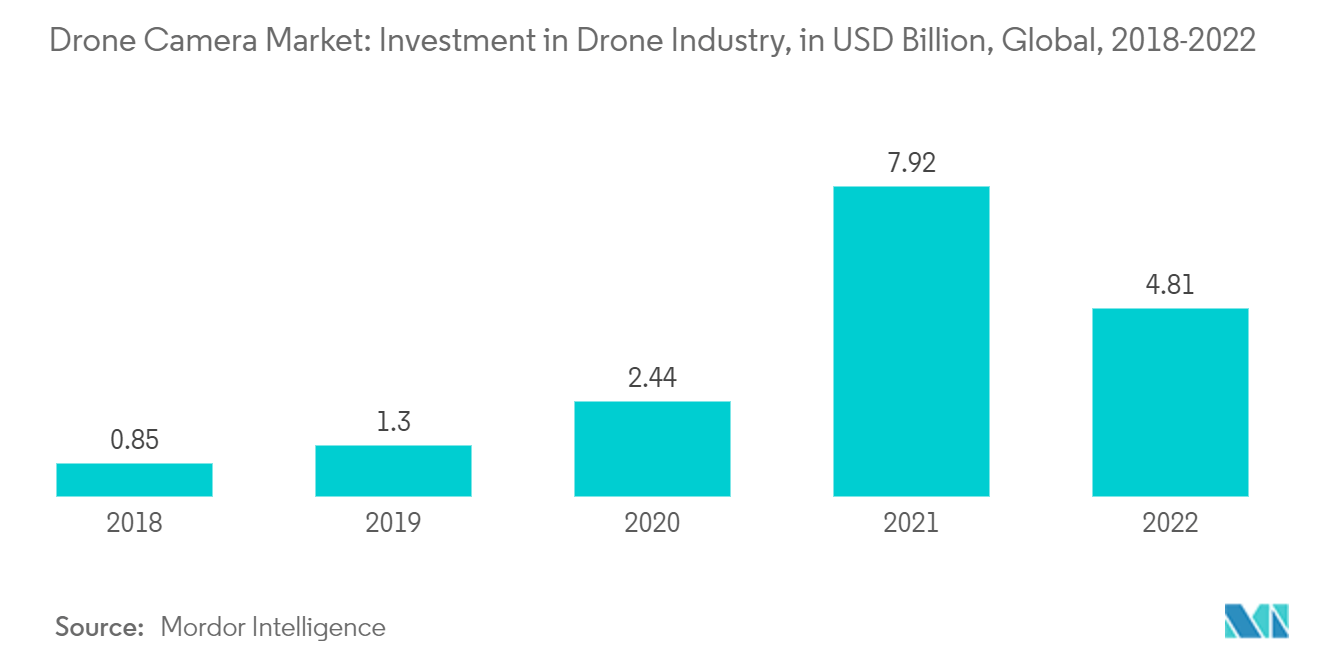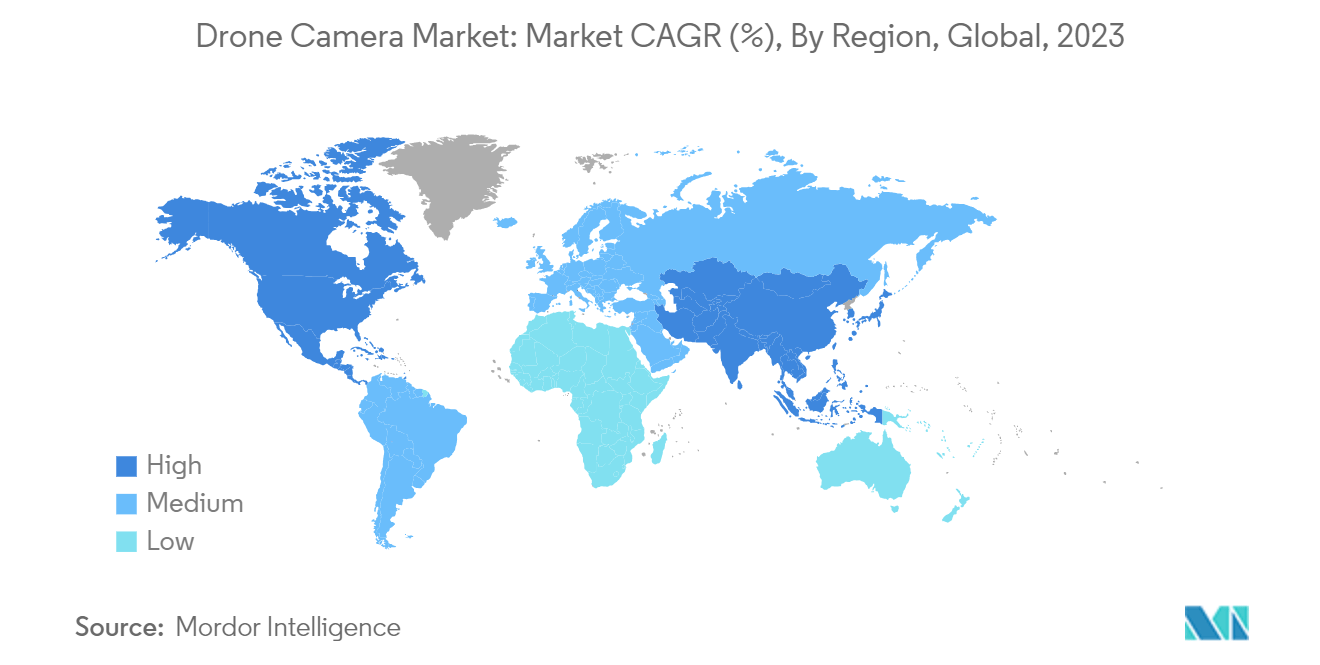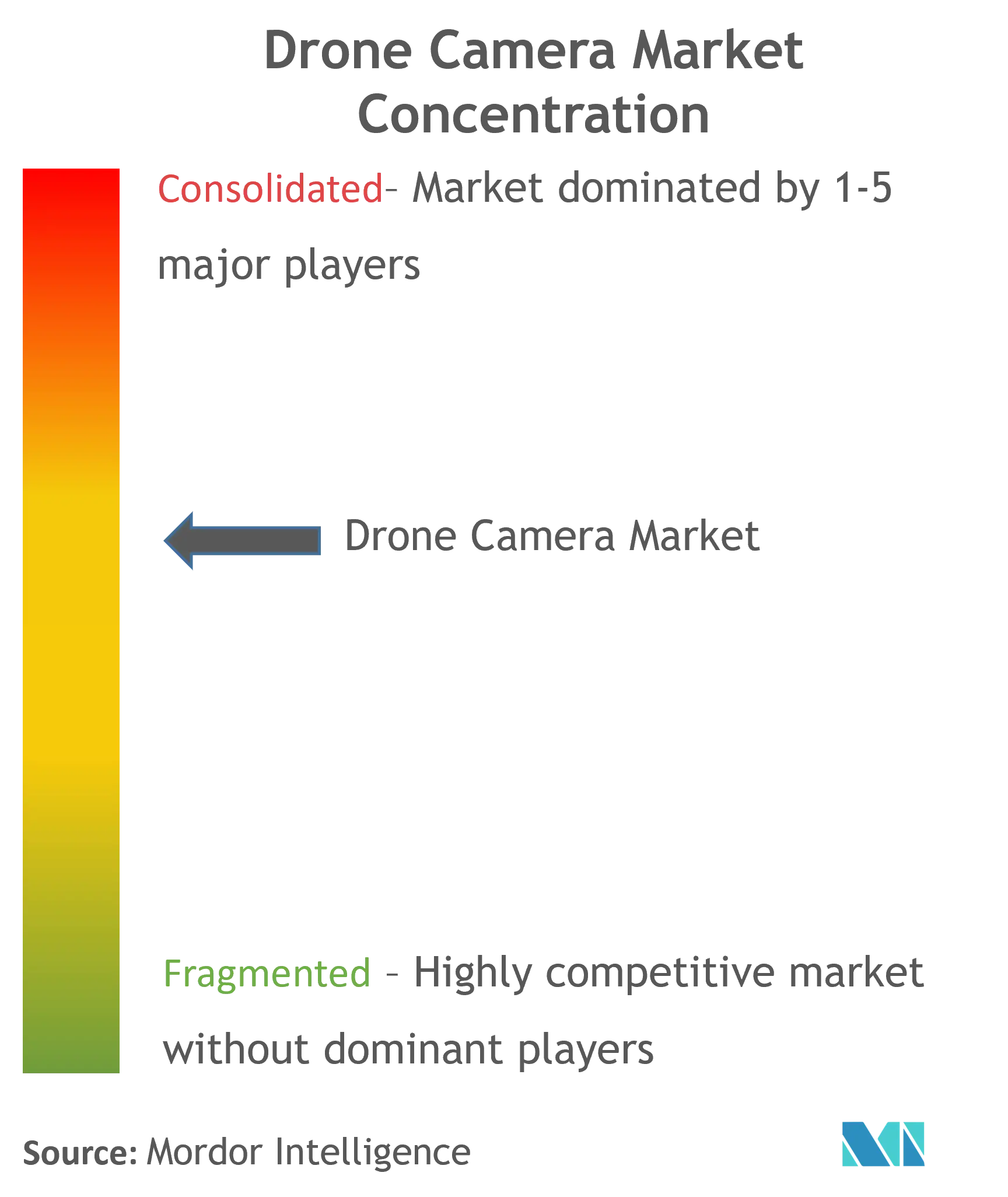
| Study Period | 2019 - 2030 |
| Market Size (2025) | USD 12.96 Billion |
| Market Size (2030) | USD 30.01 Billion |
| CAGR (2025 - 2030) | 18.28 % |
| Fastest Growing Market | Asia-Pacific |
| Largest Market | North America |
| Market Concentration | Medium |
Major Players
*Disclaimer: Major Players sorted in no particular order |
Drone Camera Market Analysis
The Drone Camera Market size is estimated at USD 12.96 billion in 2025, and is expected to reach USD 30.01 billion by 2030, at a CAGR of 18.28% during the forecast period (2025-2030).
Increasing demand for aerial photography and videography, along with reduced drone costs, is a major factor driving the market growth. Drone cameras are less expensive compared to traditional camera equipment for collecting high-quality footage. Aerial surveillance is required in situations such as crowded gatherings, large sports competitions, and summer festivals. Moreover, the growing use of drone cameras for real estate photography, mapping and surveying, agriculture, emergency response, search and rescue operations, maritime rescue, meteorology, and delivery, among other things, is driving the drone camera market.
The ability of these UAVs to aid in ISR missions, aerial surveillance, and tactical operations is likely to result in their increasing adoption of drones with camera features during the forecast period. Drones generally fly low and slow and are hard to detect and hear. In addition, they are incredibly cheap platforms, challenging defense systems to find ways of defeating them without creating an unacceptable cost-exchange ratio.
The latest technological advancements, particularly in camera quality and stabilization, are major factors driving the adoption of drones with cameras. Higher resolution cameras, improved image processing capabilities, and improved battery life are making drones more attractive for various applications. Increasing adoption of drones across industries such as media and entertainment and public safety is also fuelling market growth.
The investments in drone startups grew strongly. Investors recognized the huge potential of drones across numerous industries, leading to a growing number of funding rounds and capital investments into drone startups. This inflow of capital is enabling these startup companies to innovate and develop cutting-edge technologies, further expanding the capabilities of drones and driving the drone camera market growth.
However, the misuse of drones by evil entities to conduct physical and cyber-attacks is a major threat to public safety. In recent years, many technical and operational drone properties were misused for potential attacks. It includes performing critical operations based on violent reconnaissance and surveillance aimed at tracking specific people and certain properties, leading to safety and privacy issues. Hacking a drone is like hacking into a personal computer. Hackers need to connect to the drone by intercepting the signal, where the radio signal is unencrypted and decoded with a packet sniffer. After this, the hackers block the signal, connect the drone to their device, and manipulate the gadget to work as they want. Such security challenges lead to hesitations for the government to adopt drone services across various sectors, eventually hampering the drone camera market.
Drone Camera Market Trends
Surveillance Segment Will Showcase Remarkable Growth During the Forecast Period
The surveillance segment of the drone camera market is expected to dominate the market share while also exhibiting the highest growth rate during the forecast period. Drones monitor potential suspects or areas to keep track of their movements. Drones with cameras offer several advantages, including outstanding picture quality and ease of use for security. They can also offer thorough information on locations, provided they work well in hard-to-reach spots.
Law enforcement agencies across the world are gradually relying on drone cameras for various surveillance tasks, such as crowd monitoring, search and rescue operations, and crime scene investigation. Drones equipped with high-resolution cameras and thermal imaging technology provide law enforcement agencies with valuable situational awareness and help them improve public safety. Moreover, drones play a critical role in border surveillance, offering a cost-effective and efficient way to monitor vast territories and detect potential threats.
The latest drone camera systems with night vision features, long-range zoom lenses, and Artificial Intelligence powered object recognition enhance border security efforts. For instance, in September 2023, the government of the UK released a survey report on the usage of drones in law enforcement. It stated that various police forces in the UK use drones for applications such as monitoring major incidents and events, traffic management, searches for missing people, monitoring crime scenes, and surveillance of suspects.
Similarly, in April 2023, Devon and Cornwall Police forces announced that they are using their DJI Matrice 300 drones to monitor car and motorcycle traffic along stretches of roads known for high speed or otherwise dangerous driving. Such innovative products and the adoption of drones with cameras for such applications by various law enforcement departments are expected to drive the surveillance segment during the forecast period.

Asia-Pacific is Expected to Grow with the Highest CAGR During the Forecast Period
The Asia-Pacific region is expected to witness rapid growth during the forecast period as drones are envisioned to be adopted in large numbers by end-users based in the region. Furthermore, an increase in research and development (R&D) initiatives for cutting-edge drones for military applications such as border security and surveillance, as well as rapid digitalization, especially in rural regions, are also anticipated to drive the demand for drones and associated accessories such as drone cameras.
On this note, Asia-Pacific is rapidly adopting technology for agriculture, driven by rising labor costs. Technology-driven agriculture is much cheaper and more reliable than traditional methods. For instance, Kisan drones, or farmer drones, are more frequently used in India to assess crop damage and digitize land records. Moreover, the expanding use of drones for various industries, such as tourism, real estate, insurance, construction, meteorology, etc., is also expected to drive the demand for the drone camera market in this region.

Drone Camera Industry Overview
The drone camera market is semi-consolidated in nature, with only a few players holding a majority of the market share. Some prominent market players are Sony Corporation, Panasonic Corporation, GoPro Inc., Canon Inc., and Teledyne FLIR LLC. However, many small companies and startups entered the market in the past few years due to the high profitability of the market.
Companies are competing to gain market shares and are developing advanced technology-integrated drone hardware and software solutions that reduce human effort in applications such as mining, construction, and aerial mapping. OEMs are investing in R&D for the integration of artificial intelligence (AI) and machine learning (ML) algorithms in drone cameras.
AI-powered features such as object tracking, autonomous flight, and automated image processing enhanced the drone camera capabilities and enabled new applications. For instance, DroneAg is a UK-based company that offers a software platform that enables farmers to use drones for crop scouting and analysis. Another example is Hummingbird Technologies, which uses artificial intelligence and machine learning to process drone imagery and provide actionable insights for farmers.
Additionally, leading market players are offering drone delivery services to carry small packages to clinics and hospitals in their world countries. They are also offering collision avoidance and customizable flight pathing options to retain a competitive edge in the market. Furthermore, the rising number of drone professionals offering different services to cater to individual needs and compete in drone festivals is creating a favorable market outlook.
Drone Camera Market Leaders
-
Sony Corporation
-
Panasonic Corporation
-
GoPro Inc.
-
Canon Inc.
-
Teledyne FLIR LLC
- *Disclaimer: Major Players sorted in no particular order

Drone Camera Market News
- April 2023: Teledyne FLIR launched development kits for easy integration of the FLIR Hadron 640R thermal and visible dual camera module. The module’s compact radiometric Boson thermal camera grants visibility even in total darkness, smoke, and fog. It also features a 64MP electro-optical (EO) camera for high-definition visible imagery.
- December 2022: DJI developed a compact, ultra-lightweight camera drone, DJI Mini 3, which weighs less than 249 grams.
- June 2022: DJI launched DJI RS 3 and DJI RS 3 Pro, incorporating a range of new features. It includes a redesigned axes-locking system making the process of recording videos and capturing high-resolution images automated. By turning on the gimbal, the automated axis locks release and unfold the gimbal, allowing the operator to get started in seconds.
Drone Camera Industry Segmentation
A drone camera is an unmanned aerial vehicle (UAV) equipped with a camera that can capture photographs and videos. It is integrated with sensors that enhance the resolution and stabilize systems. It helps to provide an autonomous vision while reducing the need to physically inspect the drone and its position in the sky. It also helps with other activities, including product and food delivery, surveillance over a small region, and thermal imaging. As a result, a drone camera may be found in a variety of industrial verticals across the globe.
The drone camera market is segmented based on type, application, resolution, end user, and geography. Based on the type, the drone camera market is segmented into SD cameras and HD cameras. By application into photography & videography, thermal imaging, and surveillance. By resolution, the market is segmented into 12 MP, 12 to 20 MP, 20 to 32 MP, and 32 MP & above. By end user, the market is segmented into commercial, military, and homeland security. The report also covers the market sizes and forecasts for the aircraft tire market in major countries across different regions. For each segment, the market size is provided in terms of value (USD).
| Type | SD Cameras | ||
| HD Cameras | |||
| Application | Photography & Videography | ||
| Thermal Imaging | |||
| Surveillance | |||
| Resolution | 12 MP | ||
| 12 to 20 MP | |||
| 20 to 32 MP | |||
| 32 MP and above | |||
| Commercial | |||
| Military | |||
| Homeland Security | |||
| Geography | North America | United States | |
| Canada | |||
| Europe | United Kingdom | ||
| Germany | |||
| France | |||
| Italy | |||
| Rest of Europe | |||
| Asia-Pacific | China | ||
| India | |||
| Japan | |||
| South Korea | |||
| Rest of Asia-Pacific | |||
| Latin America | Brazil | ||
| Rest of Latin America | |||
| Middle-East and Africa | United Arab Emirates | ||
| Saudi Arabia | |||
| Egypt | |||
| Rest of Middle-East and Africa | |||
Drone Camera Market Research FAQs
How big is the Drone Camera Market?
The Drone Camera Market size is expected to reach USD 12.96 billion in 2025 and grow at a CAGR of 18.28% to reach USD 30.01 billion by 2030.
What is the current Drone Camera Market size?
In 2025, the Drone Camera Market size is expected to reach USD 12.96 billion.
Who are the key players in Drone Camera Market?
Sony Corporation, Panasonic Corporation, GoPro Inc., Canon Inc. and Teledyne FLIR LLC are the major companies operating in the Drone Camera Market.
Which is the fastest growing region in Drone Camera Market?
Asia-Pacific is estimated to grow at the highest CAGR over the forecast period (2025-2030).
Which region has the biggest share in Drone Camera Market?
In 2025, the North America accounts for the largest market share in Drone Camera Market.
What years does this Drone Camera Market cover, and what was the market size in 2024?
In 2024, the Drone Camera Market size was estimated at USD 10.59 billion. The report covers the Drone Camera Market historical market size for years: 2019, 2020, 2021, 2022, 2023 and 2024. The report also forecasts the Drone Camera Market size for years: 2025, 2026, 2027, 2028, 2029 and 2030.
Our Best Selling Reports
Drone Camera Industry Report
Statistics for the 2025 Drone Camera market share, size and revenue growth rate, created by Mordor Intelligence™ Industry Reports. Drone Camera analysis includes a market forecast outlook for 2025 to 2030 and historical overview. Get a sample of this industry analysis as a free report PDF download.




